Becoming an Architect. The Road to Registration: Amber Gray
22/8/2018
What’s the difference between an architect and an architectural designer?
Five years at university, three years’ solid work experience and a challenging registration process, says 27-year old Amber Gray in our Wellington studio.
The title ‘architect’ is used loosely in New Zealand, but it’s actually a protected term—kind of like parmesan and champagne. Without completing the registration process, architectural graduates (or anyone else) cannot call themselves an architect. But in a country that prides itself on low-cost DIY, would you encourage your son or daughter to train to be a registered architect? We asked Amber why she's doing it.
Amber, as a young girl in Te Aroha, how did you decide to become an architect?
I just always wanted to. I went to a small local high school, which meant low class numbers and more attention on each student. I think that attention and encouragement from my teachers, particularly my graphics teacher, was pivotal.
I was certainly very homesick when I first got to Wellington. I didn’t know anyone and there were 390 students in first year architecture, about the same as the entire roll of Te Aroha College.
Architecture school sounds very competitive ...
Second year was culled to just 90 students and I found the competitive nature really difficult. I spent a lot of time worrying about my marks. I loved second year, it was the best. There were still incredibly high expectations but the competition wasn’t there, and I made life-long friends. We shared a studio with the third-year students and had great tutors, my favourite was Judi Keith-Brown, who grounded our far-fetched ideas with a more realistic approach.
You still had three years of architectural training to go, and the student debt …
I admit that by the end of the fourth year, I was over it. Too many late nights and I was desperate to get out into real work.
Fifth year was thesis year and still a far cry from real work. I based mine on a concept for a Hawkes Bay winery, my dream job. I explored how the light and atmosphere, integral to impressionistic art, can relate to the experience of architecture, and how this could be related to the art of winemaking. I wanted to demonstrate the atmospheric experience of a winery rather than just the technical elements.
Like many architectural graduates, you didn’t know what to do when you finished …
I was lucky to have studied through the recession so when I graduated, I had no trouble finding work. I joined Pelorous Architecture working on commercial interiors for two years and then successfully applied for this role at HMOA.
What’s the process for becoming a Registered Architect?
You need 140 weeks’ experience working for a Registered Architect—recorded and signed-off. You also need to submit a case study of a completed project to the NZRAB before being invited to a three hour interview that covers twelve possible topics. You need to pass the interview to achieve registration!
I plan to be a Registered Architect within the next year or two.
You’ve been working on a social housing project, what have you learned so far?
Architecture school doesn’t teach you much about technical issues or project management. I’ve learnt that the realities of architecture are very different from what I thought they would be—it’s a lot more practical! (try telling a 13-year-old girl that architecture is not just designing houses and seeing them built).
Working on the Hanson St Housing New Zealand flats in Wellington has taught me so much. As well as the practical experience of a job of this scale, I’ve learnt it’s the little things that make a difference to how architecture can contribute to quality of life.
I don’t think most New Zealanders understand the value of good design, there needs to be a shift. I’d love to do more social housing—architecture is not just about rich people.
You’ve already shown a lot of initiative in the office …
I’ve started fortnightly office talks to increase my own understanding of the twelve topics I need for registration but also to create more discussion within the studio. We focus on a different topic each time, for example liability, ethics or health and safety. I’ve found it’s not just me learning, the sessions seem to be a healthy way for the office to come together.
I also fire out ‘Fun Facts Tuesday’ each week. These are interesting gems about architectural projects around the world. It’s a good way to connect with our other studios in Auckland, Tauranga and Christchurch.
What’s it like being a young woman in architecture?
Largely positive. I’ve heard about issues women have had on-site, but I’ve never experienced anything first hand.
I’m aware that when women architects have children, they can become less visible in their industry, or leave it all together. Issues such as this are definitely on the radar now, we’re a sector that’s proactive in trying to resolve gender inequity. I’m a member of Architecture Women NZ and was pleased to see that NZIA and Engineering NZ recently launched the Diversity Agenda. We’ve started something and as with any campaign for change, you have to start somewhere.
Images: Bruce Foster


